Insights into the Structure and Dynamics of Imidazolium Ionic Liquid and Tetraethylene Glycol Dimethyl Ether Cosolvent Mixtures: A Molecular Dynamics Approach
Abstract
:1. Introduction
2. Materials and Methods
2.1. Force Field Parameters
2.2. Simulation Details
3. Results
3.1. Density for Evaluation of Forcefields
3.2. Structural Analysis
3.2.1. Morphologies of Microscopic Structure in IL/TEGDME Mixtures
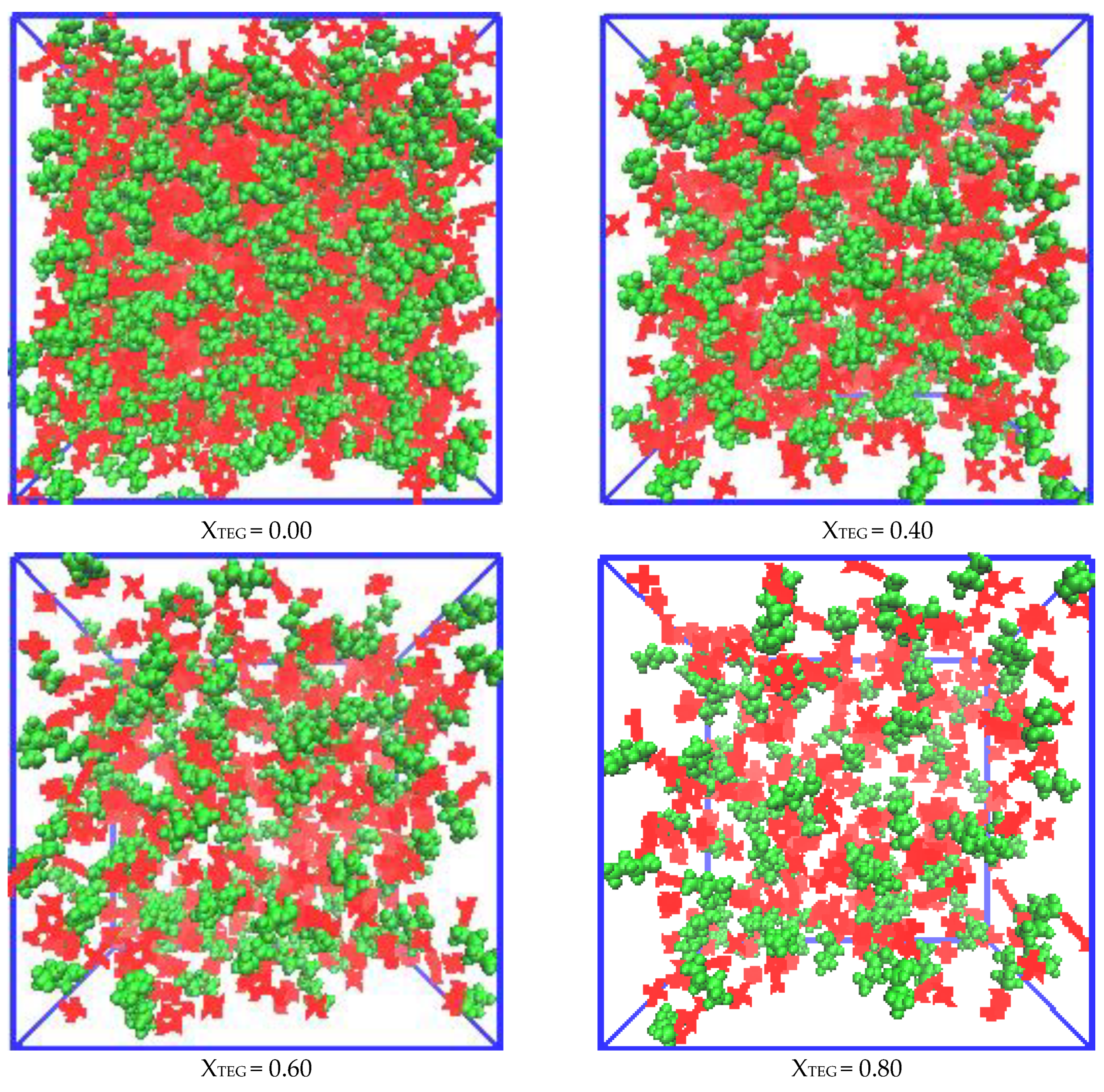
3.2.2. Radial Distribution Functions Analysis of Microscopic Ionic Structure
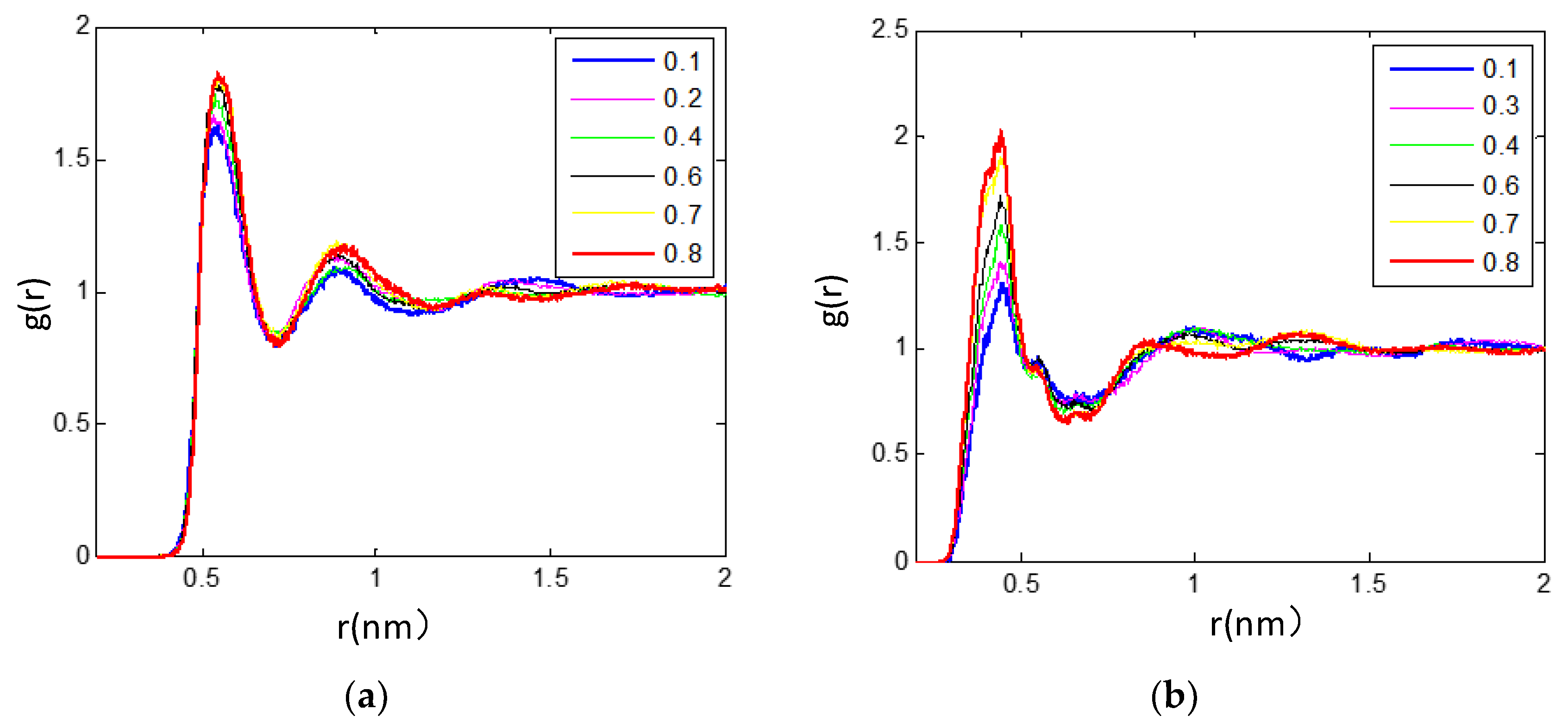
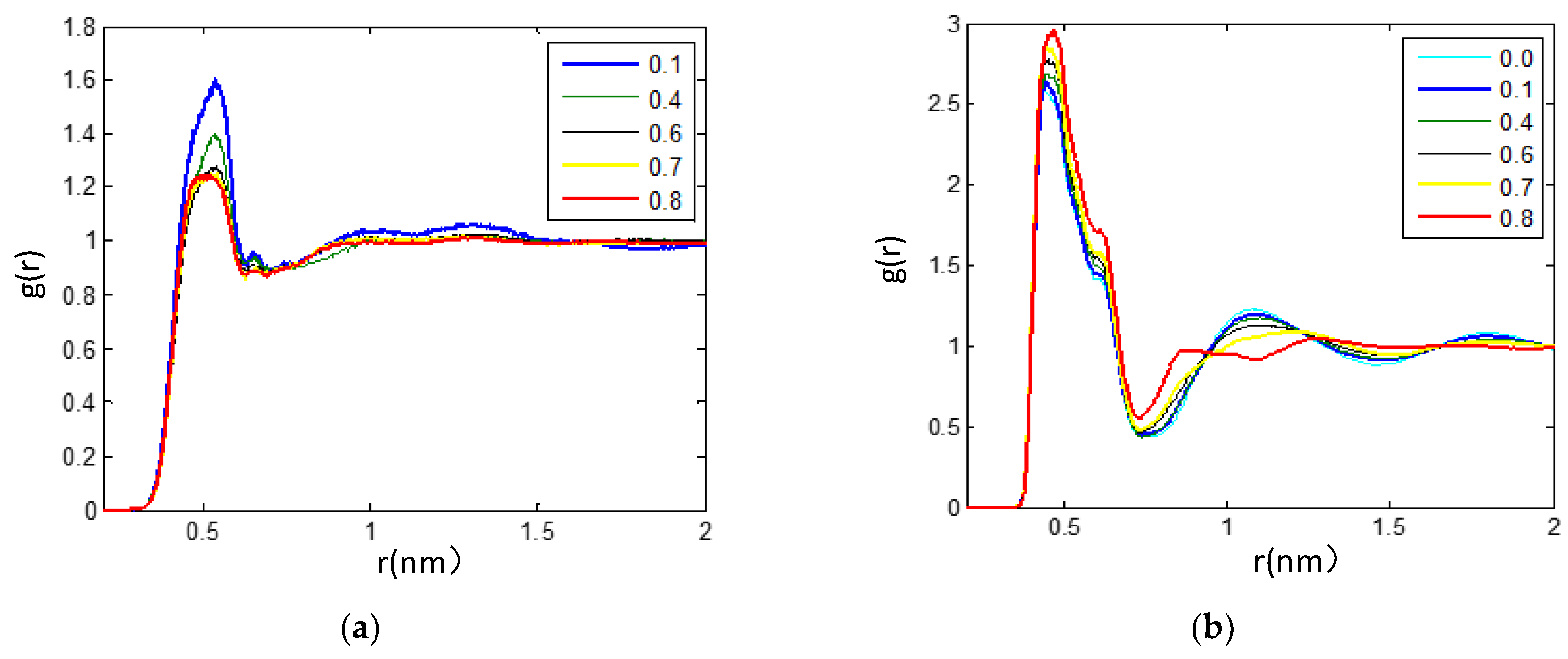

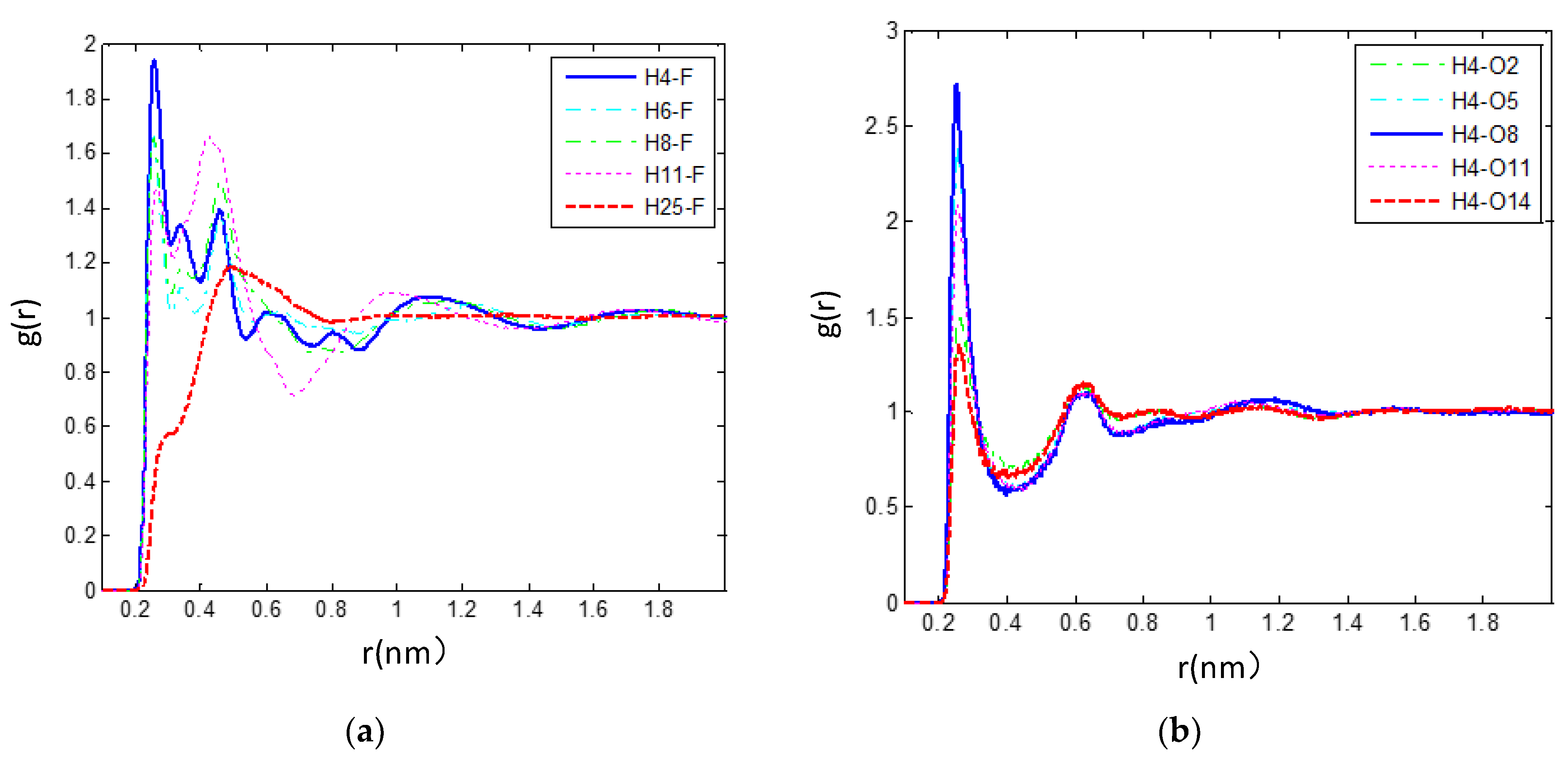
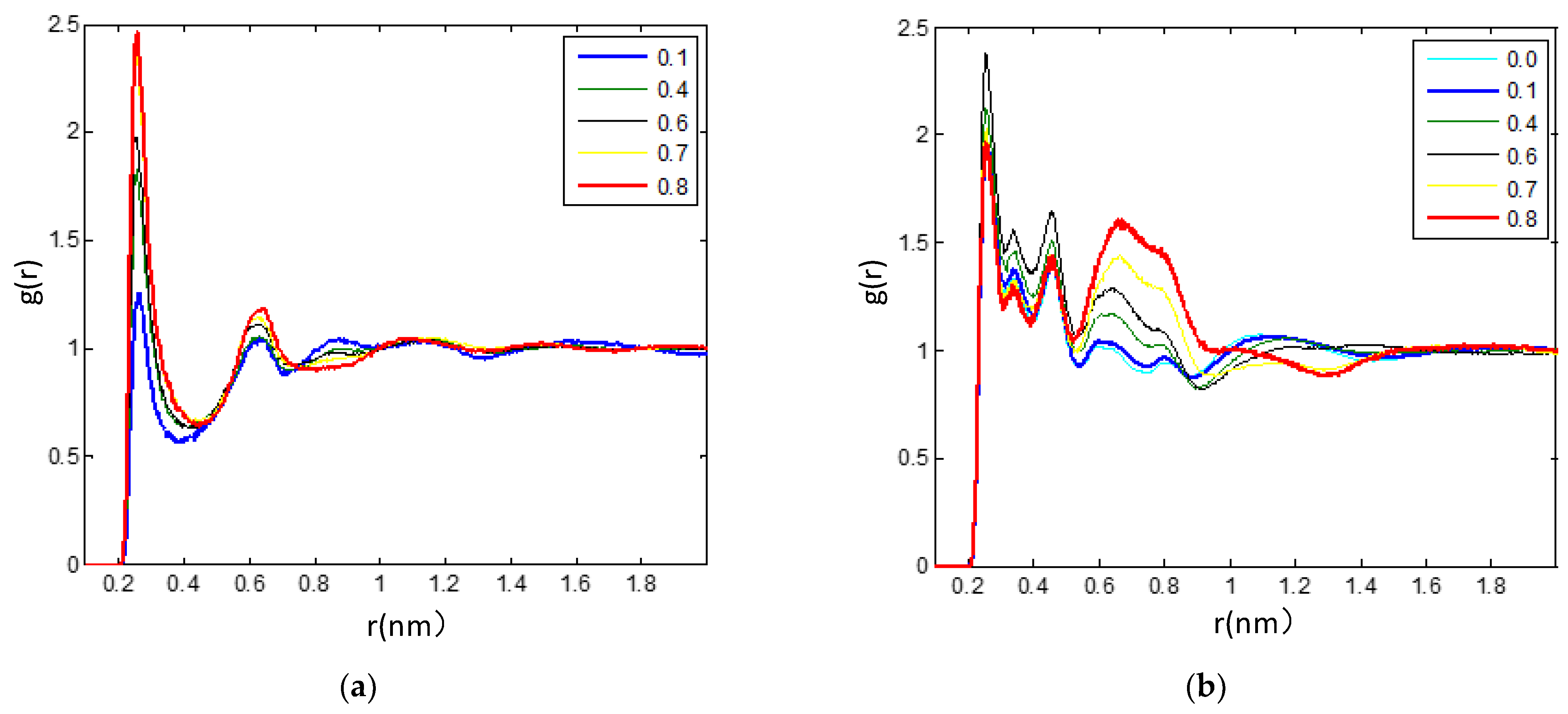
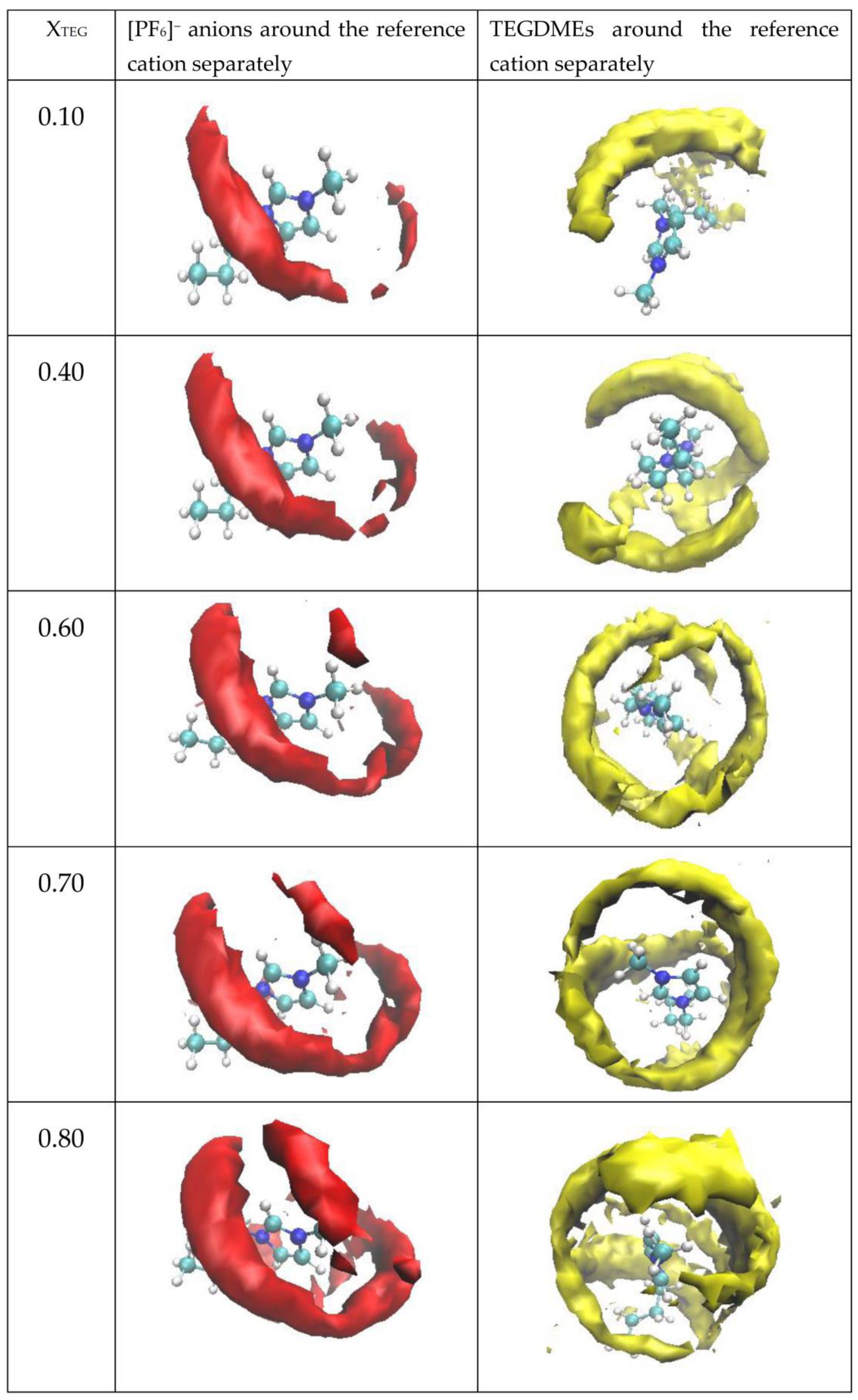
3.2.3. The Hydrogen Bonds in the IL/TEGDME Mixture
3.2.4. Spatial Distribution Functions
3.3. Dynamical and Transport Properties of [bmim][PF6]/TEGDME Mixtures
3.3.1. Rotational Dynamics of C153 in [bmim][PF6] and TEGDME Mixtures
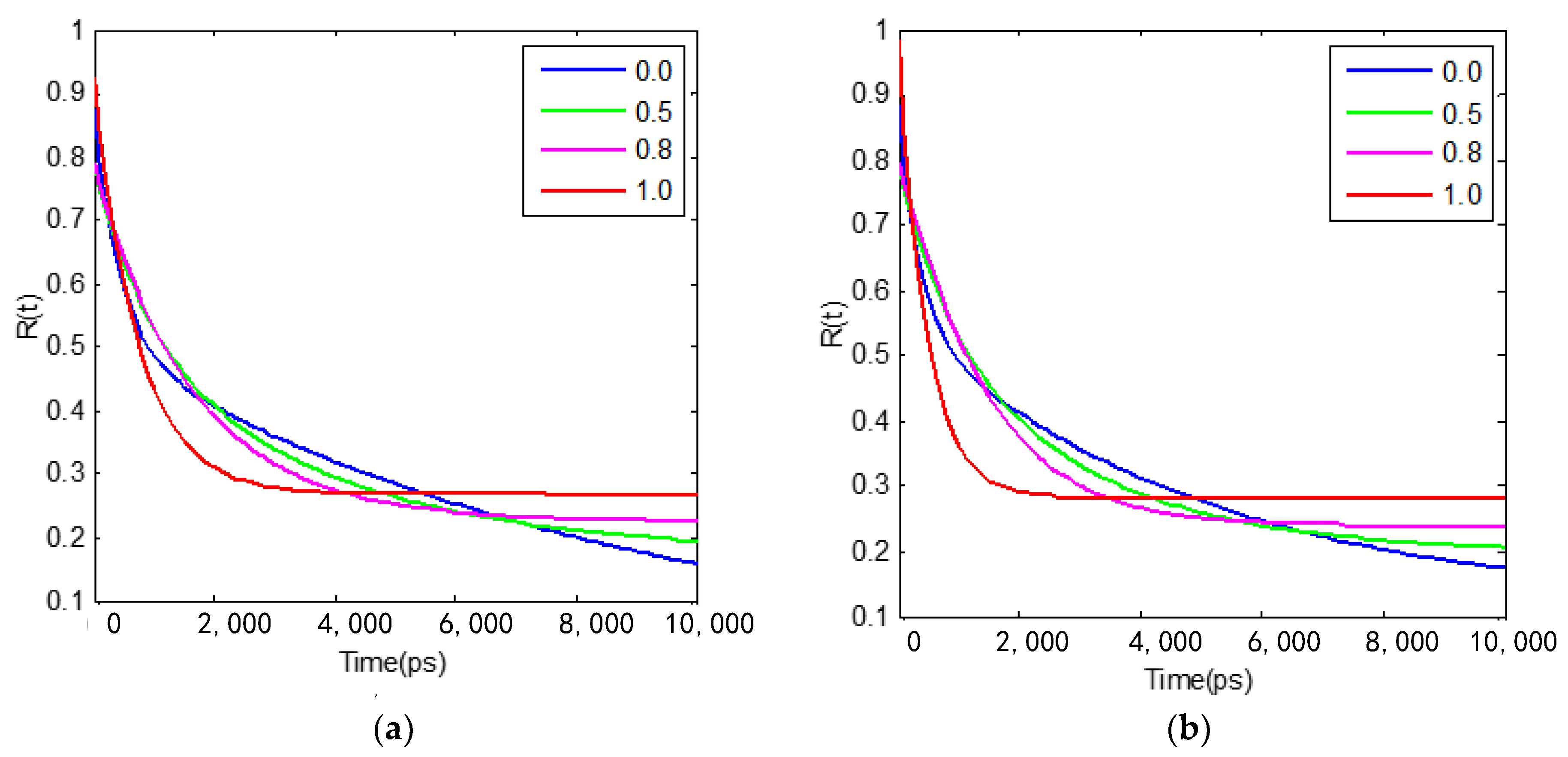
3.3.2. Diffusion Dynamics of Ions in [bmim][PF6] and TEGDME Mixtures
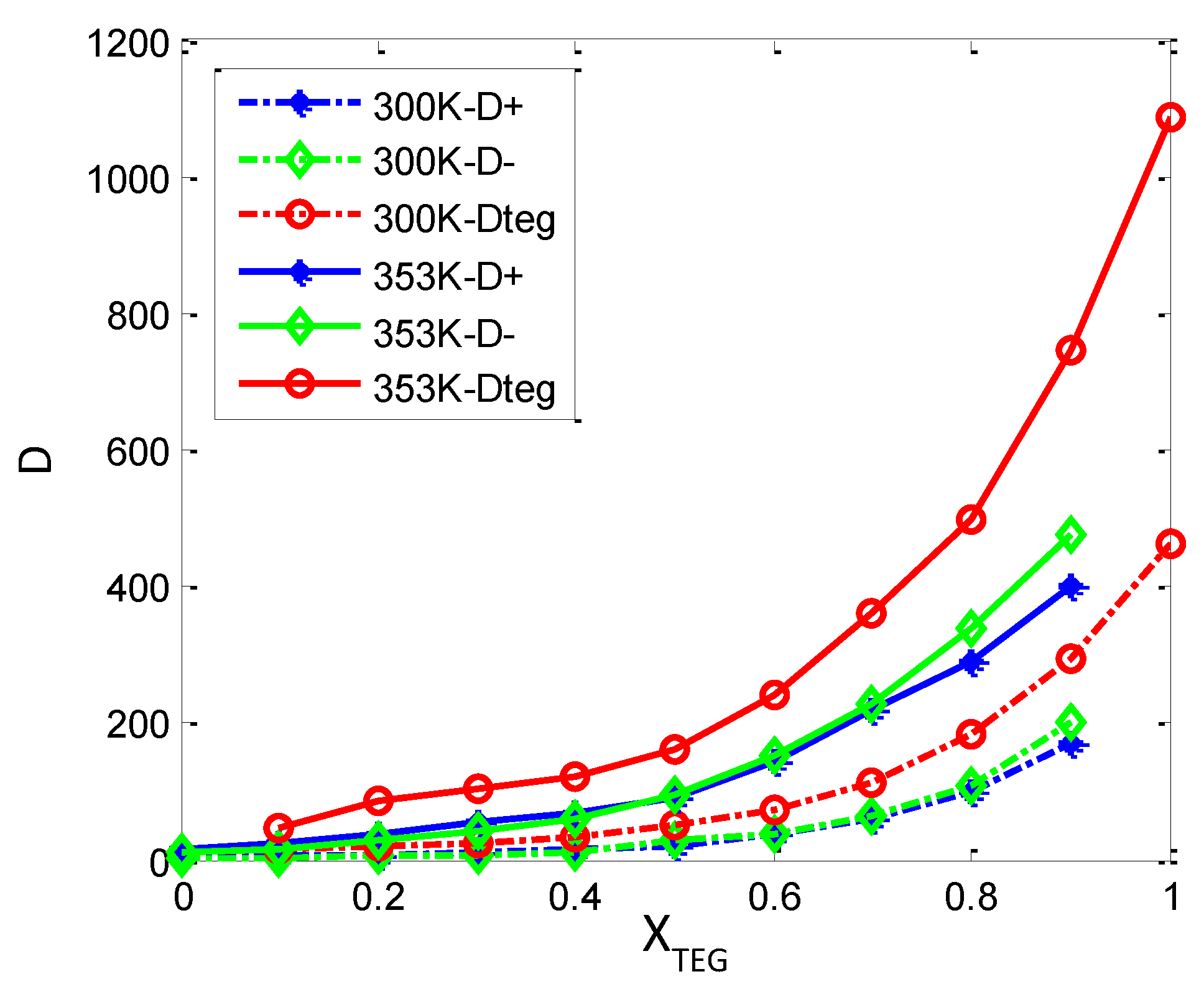

4. Conclusions
Author Contributions
Funding
Data Availability Statement
Acknowledgments
Conflicts of Interest
References
- Rogers, R.D.; Seddon, K.R. Ionic liquids-solvents of the future. Science 2003, 302, 792–793. [Google Scholar] [CrossRef] [PubMed]
- Lu, W.; Fadeev, A.G.; Qi, B.; Smela, E.; Mattes, B.R.; Ding, J.; Spinks, G.M.; Mazurkiewicz, J.; Zhou, D.; Wallace, G.G.; et al. Use of ionic liquids for pi-conjugated polymer electrochemical devices. Science 2002, 297, 983–987. [Google Scholar] [CrossRef] [Green Version]
- Armand, M.; Endres, F.; MacFarlane, D.R.; Ohno, H.; Scrosati, B. Ionic-Liquid Materials for the Electrochemical Challenges of the Future. Nat. Mater. 2009, 8, 621–629. [Google Scholar] [CrossRef] [PubMed]
- Su, Y.C.; Liu, Y.A. Selection of Prediction Methods for Thermophysical Properties for Process Modeling and Product Design of Biodiesel Manufacturing. Ind. Eng. Chem. Res. 2011, 50, 6809–6836. [Google Scholar] [CrossRef] [Green Version]
- Plechkova, N.V.; Seddon, K.R. Applications of ionic liquids in the chemical industry. Chem. Soc. Rev. 2008, 37, 123–150. [Google Scholar] [CrossRef]
- Niedermeyer, H.; Hallett, J.P.; Villar-Garcia, I.J.; Hunt, P.A.; Welton, T. Mixtures of Ionic Liquids. Chem. Soc. Rev. 2012, 41, 7780–7802. [Google Scholar] [CrossRef] [PubMed] [Green Version]
- Doroodian, A.; Dengler, J.E.; Genest, A.; Rösch, N.; Rieger, B. Methylguanidinium Borohydride: An Ionic-Liquid-Based Hydrogen-Storage Material. Angew. Chem. Int. Ed. 2010, 49, 1871–1873. [Google Scholar] [CrossRef]
- Aparicio, S.; Atilhan, M.; Karadas, F. Thermophysical Properties of Pure Ionic Liquids: Review of Present Situation. Ind. Eng. Chem. Res. 2010, 49, 9580–9595. [Google Scholar] [CrossRef]
- Forse, A.C.; Griffin, J.M.; Merlet, C.; Bayley, P.M.; Wang, H.; Simon, P.; Grey, C.P. NMR study of ion dynamics and charge storage in ionic liquid supercapacitors. J. Am. Chem. Soc. 2015, 137, 7231–7242. [Google Scholar] [CrossRef]
- Gouverneur, M.; Kopp, J.; Wüllen, L.; Van Schönho, M. Direct determination of ionic transference numbers in ionic liquids by electrophoretic NMR. Phys. Chem. Chem. Phys. 2015, 17, 30680–30686. [Google Scholar] [CrossRef] [Green Version]
- Borodin, O.; Gorecki, W.; Smith, G.D.; Armand, M. Molecular Dynamics Simulation and Pulsed-Field Gradient NMR Studies of Bis(fluorosulfonyl)imide (FSI) and Bis[(trifluoromethyl)sulfonyl]imide (TFSI)-Based Ionic Liquids. J. Phys. Chem. B 2010, 114, 6786–6798. [Google Scholar] [CrossRef]
- Hardacre, C.; Holbrey, J.D.; Mullan, C.L.; Youngs, T.G.A.; Bowron, D.T. Small Angle Neutron Scattering from 1-Alkyl-3- methylimidazolium Hexafluorophosphate Ionic Liquids ([Cnmim]-[PF6], n = 4, 6, and 8). J. Chem. Phys. 2010, 133, 074510. [Google Scholar] [CrossRef]
- Annapureddy, H.V.; Kashyap, H.K.; De Biase, P.M.; Margulis, C.J. What is the Origin of the Prepeak in the X-ray Scattering of Imidazolium-Based Room-Temperature Ionic Liquids? J. Phys. Chem. B 2010, 114, 16838–16846. [Google Scholar] [CrossRef] [PubMed]
- Yamauchi, H.; Maeda, Y. LCST and UCST behavior of poly(Nisopropylacrylamide) in DMSO/water mixed solvents studied by IR and micro-raman spectroscopy. J. Phys. Chem. B 2007, 111, 12964–12968. [Google Scholar] [CrossRef] [PubMed]
- Li, B.X.; Qiu, M.; Long, S.R.; Wang, X.F.; Guo, Q.J.; Xia, A.D. Unraveling heterogeneous microviscosities of the 1-alkyl-3- methylimidazolium hexafluorophosphate ionic liquids with different chain lengths. Phys. Chem. Chem. Phys. 2013, 15, 16074–16081. [Google Scholar] [CrossRef] [PubMed]
- Li, B.X.; Wang, Y.Y.; Wang, X.F.; Vdovic, S.; Guo, Q.J.; Xia, A.D. Spectroscopic Evidence for Unusual Microviscosity in Imidazolium Ionic Liquid and Tetraethylene Glycol Dimethyl Ether Cosolvent Mixtures. J. Phys. Chem. B 2012, 116, 13272–13281. [Google Scholar] [CrossRef] [PubMed] [Green Version]
- Stoppa, A.; Hunger, J.; Buchner, R. Conductivities of Binary Mixtures of Ionic Liquids with Polar Solvents. J. Chem. Eng. Data 2009, 54, 472–479. [Google Scholar] [CrossRef]
- Hogan, C.J., Jr.; de la Mora, J.F. Tandem Ion Mobility-Mass Spectrometry (IMS-MS) Study of Ion Evaporation from Ionic Liquid-Acetonitrile Nanodrops. Phys. Chem. Chem. Phys. 2009, 11, 8079–8090. [Google Scholar] [CrossRef]
- Richey, F.W.; Tran, C.; Kalra, V.; Elabd, Y.A. Ionic liquid dynamics in nanoporous carbon nanofibers in supercapacitors measured with in operando infrared spectroelectrochemistry. J. Phys. Chem. C 2014, 118, 21846–21855. [Google Scholar] [CrossRef]
- Chakrabarty, D.; Seth, D.; Chakraborty, A.; Sarkar, N. Dynamics of solvation and rotational relaxation of coumarin 153 in ionic liquid confined nanometer-sized microemulsions. J. Phys. Chem. B 2005, 109, 5753–5758. [Google Scholar] [CrossRef]
- Seth, D.; Sarkar, S.; Sarkar, N. Dynamics of solvent and rotational relaxation of coumarin-153 in room-temperature ionic liquid 1-butyl-3-methyl imidazolium tetrafluoroborate confined in poly(oxyethylene glycol) ethers containing micelles. J. Phys. Chem. B 2007, 111, 4781–4787. [Google Scholar] [CrossRef]
- Fumino, K.; Wulf, A.; Ludwig, R. Strong, Localized and Directional Hydrogen Bonds Fluidize Ionic Liquids. Angew. Chem. Int. Ed. 2008, 47, 8731–8734. [Google Scholar] [CrossRef]
- Peppel, T.; Roth, C.; Paschek, D.; Kocherling, M.; Ludwig, R. The Influence of Hydrogen-Bond Defects on the Properties of Ionic Liquids. Angew. Chem. Int. Ed. 2011, 50, 6661–6665. [Google Scholar] [CrossRef]
- Zheng, Y.; Wang, N.; Luo, J.; Zhou, Y.; Yu, Z. Hydrogen-Bonding Interactions Between [BMIM][BF4] and Acetonitrile. Phys. Chem. Chem. Phys. 2013, 15, 18055–18064. [Google Scholar] [CrossRef] [PubMed]
- Pramanik, R.; Rao, V.G.; Sarkar, S.; Ghatak, C.; Setua, P.; Sarkar, N.J. To Probe the Interaction of Methanol and Acetonitrile with the Ionic Liquid N,N,N-Trimethyl-N-propyl Ammonium Bis(trifluoromethanesulfonyl) Imide at Different Temperatures by Solvation Dynamics Study. Phys. Chem. B 2009, 113, 8626–8634. [Google Scholar] [CrossRef] [PubMed]
- Trivedi, S.; Pandey, S. Interactions within a Ionic Liquid plus Poly(ethylene glycol) Mixture Revealed by Temperature-Dependent Synergistic Dynamic Viscosity and Probe-Reported Microviscosity. J. Phys. Chem. B 2011, 115, 7405–7416. [Google Scholar] [CrossRef] [PubMed]
- Sarkar, A.; Trivedi, S.; Pandey, S. Polymer Molecular Weight-Dependent Unusual Fluorescence Probe Behavior within 1-Butyl-3-methylimidazolium Hexafluorophosphate plus Poly(ethylene glycol). J. Phys. Chem. B 2009, 113, 7606–7614. [Google Scholar] [CrossRef]
- Sarkar, A.; Trivedi, S.; Baker, G.A.; Pandey, S. Multiprobe Spectroscopic Evidence for “Hyperpolarity” within 1-Butyl-3- methylimidazolium Hexafluorophosphate Mixtures with Tetraethylene glycol. J. Phys. Chem. B 2008, 112, 14927–14936. [Google Scholar] [CrossRef]
- Stoppa, A.; Hunger, J.; Hefter, G.; Buchner, R. Structure and Dynamics of 1-N-Alkyl-3-NMethylimidazolium Tetrafluoroborate + Acetonitrile Mixtures. J. Phys. Chem. B 2012, 116, 7509–7521. [Google Scholar] [CrossRef]
- Kalugin, O.N.; Voroshylova, I.V.; Riabchunova, A.V.; Lukinova, E.V.; Chaban, V.V. Conductometric Study of Binary Systems Based on Ionic Liquids and Acetonitrile in a Wide Concentration Range. Electrochim. Acta 2013, 105, 188–199. [Google Scholar] [CrossRef]
- Coadou, E.; Timperman, L.; Jacquemin, J.; Galiano, H.; Hardacre, C.; Anouti, M. Comparative Study on Performances of Trimethyl-Sulfonium and Trimethyl-Ammonium Based Ionic Liquids in Molecular Solvents as Electrolyte for Electrochemical Double Layer Capacitors. J. Phys. Chem. C 2013, 117, 10315–10325. [Google Scholar] [CrossRef]
- Chevrot, G.; Fileti, E.E.; Chaban, V.V. Enhanced stability of the model mini-protein in amino acid ionic liquids and their aqueous solutions. J. Comput. Chem. 2015, 36, 2044–2051. [Google Scholar] [CrossRef] [Green Version]
- Chevrot, G.; Fileti, E.E.; Chaban, V.V. Protein remains stable at unusually high temperatures when solvated in aqueous mixtures of amino acid based ionic liquids. J. Mol. Modeling 2016, 22, 258. [Google Scholar] [CrossRef] [PubMed]
- Zhang, Y.; Maginn, E.J. Direct Correlation Between Ionic Liquid Transport Properties and Ion Pair Lifetimes: A Molecular Dynamics Study. J. Phys. Chem. Lett. 2015, 6, 700–705. [Google Scholar] [CrossRef] [PubMed]
- Huang, Y.; Zhao, Y.; Zeng, S.; Zhang, X.; Zhang, S. Density Prediction of Mixtures of Ionic Liquids and Molecular Solvents Using Two New Generalized Models. Ind. Eng. Chem. Res. 2014, 53, 15270–15277. [Google Scholar] [CrossRef]
- Li, W.; Zhang, Z.; Han, B.; Hu, S.; Xie, Y.; Yang, G. Effect of Water and Organic Solvents on the Ionic Dissociation of Ionic Liquids. J. Phys. Chem. B 2007, 111, 6452–6456. [Google Scholar] [CrossRef]
- Menjoge, A.; Dixon, J.; Brennecke, J.F.; Maginn, E.J.; Vasenkov, S. Influence of Water on Diffusion in Imidazolium-Based Ionic Liquids: A Pulsed Field Gradient NMR study. J. Phys. Chem. B 2009, 113, 6353–6359. [Google Scholar] [CrossRef]
- Rollet, A.L.; Porion, P.; Vaultier, M.; Billard, I.; Deschamps, M.; Bessada, C.; Jouvensal, L. Anomalous Diffusion of Water in [BMIM][TFSI] Room-Temperature Ionic Liquid. J. Phys. Chem. B 2007, 111, 11888–11891. [Google Scholar] [CrossRef] [PubMed]
- Hall, C.A.; Le, K.A.; Rudaz, C.; Radhi, A.; Lovell, C.S.; Damion, R.A.; Budtova, T.; Ries, M.E. Macroscopic and Microscopic Study of 1-Ethyl-3-methyl-imidazolium Acetate−Water Mixtures. J. Phys. Chem. B 2012, 116, 12810–12818. [Google Scholar] [CrossRef] [PubMed]
- Alam, T.M.; Dreyer, D.R.; Bielawski, C.W.; Ruoff, R.S. Combined Measurement of Translational and Rotational Diffusion in Quaternary Acyclic Ammonium and Cyclic Pyrrolidinium Ionic Liquids. J. Phys. Chem. B 2013, 117, 1967–1977. [Google Scholar] [CrossRef]
- Liu, H.; Maginn, E. A Molecular Dynamics Investigation of the Structural and Dynamic Properties of the Ionic Liquid 1-n-Butyl-3- Methylimidazolium Bis(Trifluoromethanesulfonyl)Imide. J. Chem. Phys. 2011, 135, 124507. [Google Scholar] [CrossRef]
- Lopes, J.N.C.; Deschamps, J.; Padua, A.H. Modeling Ionic Liquids Using a Systematic All-Atom Force Field. J. Phys. Chem. B 2004, 108, 2038–2047. [Google Scholar] [CrossRef]
- Lopes, J.N.C.; Padua, A.H.; Shimizu, K. Molecular Force Field for Ionic Liquids IV: Trialkylimidazolium and Alkoxycarbonyl-Imidazolium Cations; Alkylsulfonate and Alkylsulfate Anions. J. Phys. Chem. B 2008, 112, 5039–5046. [Google Scholar] [CrossRef] [PubMed]
- Lopes, J.N.C.; Padua, A.H. CL&P: A Generic and Systematic Force Field for Ionic Liquids Modeling. Theor. Chem. Acc. 2012, 131, 1129–1140. [Google Scholar]
- Jorgensen, W.L.; Briggs, J.M.; Contreras, M.L. Relative partition coefficients for organic solutes from fluid simulations. J. Phys. Chem. 1990, 94, 1683–1686. [Google Scholar] [CrossRef]
- Jorgensen, W.L.; Maxwell, D.S.; Tirado-Rives, J. Development and Testing of the OPLS All-Atom Force Field on Conformational Energetics and Properties of Organic Liquids. J. Am. Chem. Soc. 1996, 118, 11225. [Google Scholar] [CrossRef]
- Voroshylova, I.V.; Chaban, V.V. Atomistic Force Field for Pyridinium-Based Ionic Liquids: Reliable Transport Properties. J. Phys. Chem. B 2014, 118, 10716–10724. [Google Scholar] [CrossRef] [PubMed] [Green Version]
- Chaban, V.V.; Voroshylova, I.V. Systematic Refinement of Canongia Lopes–Pádua Force Field for Pyrrolidinium-Based Ionic Liquids. J. Phys. Chem. B 2015, 119, 6242–6249. [Google Scholar] [CrossRef] [PubMed] [Green Version]
- Chaban, V.V. Polarizability versus mobility: Atomistic force field for ionic liquids. Phys. Chem. Chem. Phys. 2011, 13, 16055–16062. [Google Scholar] [CrossRef] [Green Version]
- Jorgensen, W.L.; Madura, J.D.; Swenson, C.J. Optimized intermolecular potential functions for liquid hydrocarbons. J. Am. Chem. Soc. 1984, 106, 6638–6646. [Google Scholar] [CrossRef]
- Hess, B.; Kutzner, C.; Van Der Spoel, D.; Lindahl, E. GROMACS 4: Algorithms for highly efficient, load-balanced, and scalable molecular simulation. J. Chem. Theory Comput. 2008, 4, 435–447. [Google Scholar] [CrossRef] [PubMed] [Green Version]
- Brehm, M.; Kirchner, B. TRAVIS—A Free Analyzer and Visualizer for Monte Carlo and Molecular Dynamics Trajectories. J. Chem. Inf. Model. 2011, 51, 2007–2023. [Google Scholar] [CrossRef] [PubMed] [Green Version]
- Humphrey, W.; Dalke, A.; Schulten, K. VMD: Visual Molecular Dynamics. J. Mol. Graphics 1996, 14, 33–38. [Google Scholar] [CrossRef]
- Morrow, T.I.; Maginn, E.J. Molecular Dynamics Study of the Ionic Liquid 1-n-Butyl-3-methylimidazolium Hexafluorophosphate. J. Phys. Chem. B 2002, 106, 12807–12813. [Google Scholar] [CrossRef]
- Liu, Z.P.; Huang, S.P.; Wang, W.C. A Refined Force Field for Molecular Simulation of Imidazolium-Based Ionic Liquids. J. Phys. Chem. B 2004, 108, 12978–12989. [Google Scholar] [CrossRef]
- Liu, Z.P.; Wu, X.P.; Wang, W.C. A novel united-atom force field for imidazolium-based ionic liquids. Phys. Chem. Chem. Phys. 2006, 8, 1096–1104. [Google Scholar] [CrossRef]
- Borodin, O. Polarizable Force Field Development and Molecular Dynamics Simulations of Ionic Liquids. J. Phys. Chem. B 2009, 113, 11463–11478. [Google Scholar] [CrossRef]
- Liu, Z.; Chen, T.; Bell, A.; Smit, B. Improved United-Atom Force Field for 1-Alkyl-3-methylimidazolium Chloride. J. Phys. Chem. B 2010, 114, 4572–4582. [Google Scholar] [CrossRef]
- Endo, T.; Kato, T.; Nishikawa, K. Effects of Methylation at the 2 Position of the Cation Ring on Phase Behaviors and Conformational Structural of Imidazolium-Based Ionic Liquids. J. Phys. Chem. B 2010, 114, 9201–9208. [Google Scholar] [CrossRef]
- Fredlake, C.P.; Crosthwaite, J.M.; Hert, D.G.; Aki, S.N.V.K.; Brennecke, J.F. Thermodynamical properties of imidazolium-based ionic liquids. J. Chem. Eng. Data 2004, 49, 954–961. [Google Scholar] [CrossRef]
- Ahn, H.J.; Kim, K.W.; Ahn, J.H.; Cho, K.K.; Nam, T.H.; Kim, J.U.; Cho, G.B.; Ryu, H.S. Discharge behavior of lithium/sulfur cell with TEGDME based electrolyte at low temperature. J. Power Sources 2006, 163, 201–206. [Google Scholar]
- Taylor, R.; Kennard, O. Crystallographic evidence for the existence of C-H···O, C-H···N, and C-H···C1 hydrogen-bonds. J. Am. Chem. Soc. 1982, 104, 5063–5070. [Google Scholar] [CrossRef]
- Hinze, G.; Diezemann, G.; Basché, T. Rotational Correlation Functions of Single Molecules. Phys. Rev. Lett. 2004, 93, 203001. [Google Scholar] [CrossRef] [PubMed] [Green Version]
- Chen, W.T.; Hsu, W.Y.; Lin, M.Y.; Tai, C.C.; Wang, S.P.; Sun, I.W. Isolated BMI + Cations are More than Isolated PF6 Anions in the Room Temperature 1-Butyl-3-Methylimidazolium Hexafluorophosphate (BMI-PF6) Ionic Liquid. J. Chin. Chem. Soc. 2010, 57, 1293–1298. [Google Scholar] [CrossRef]
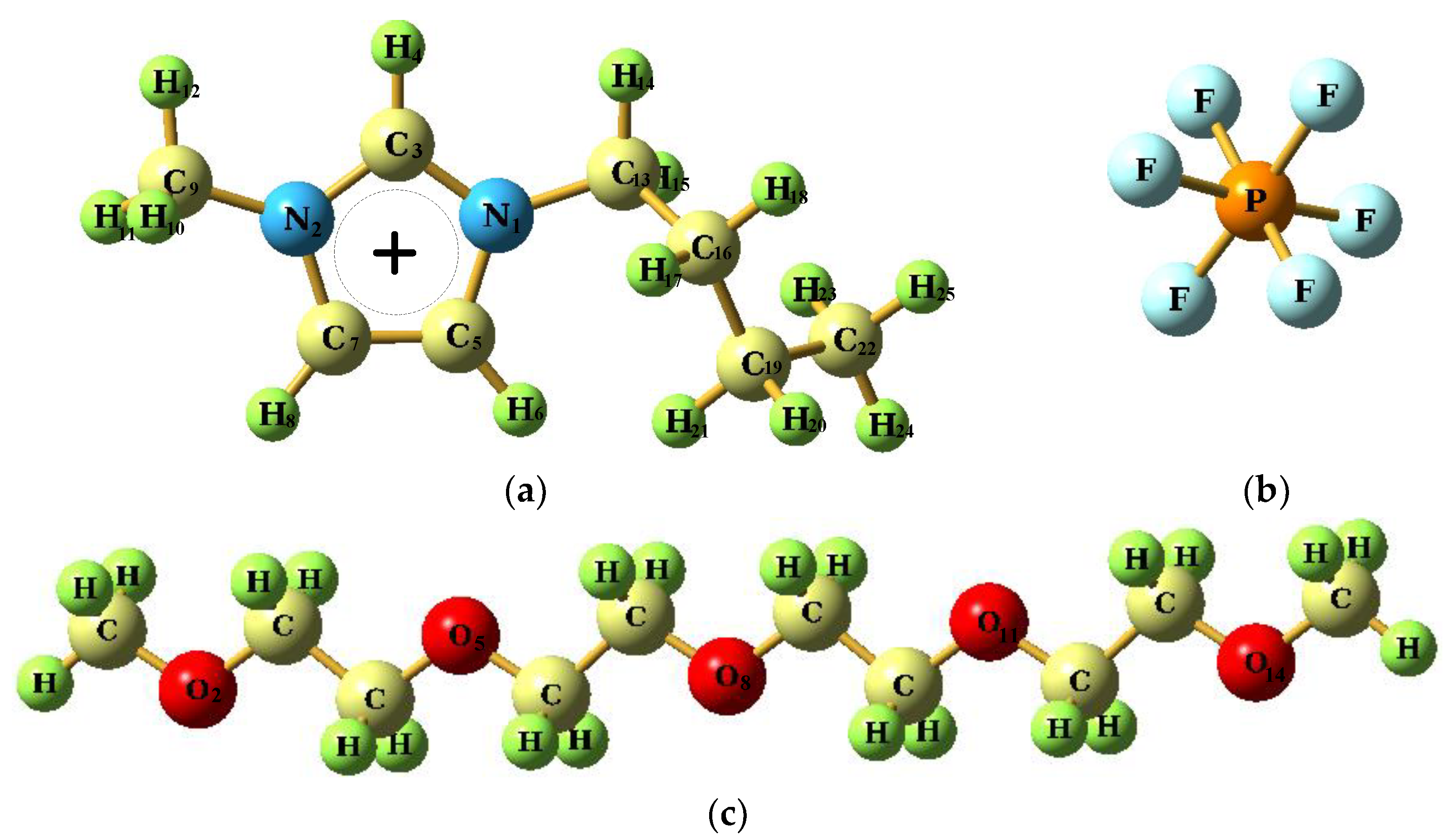
| xTEG | NTEG | Nion Pairs | Total Atoms | Box Sizes (X, Y, Z) /Å | Rcutoff/nm | Density g/cm3 |
|---|---|---|---|---|---|---|
| 0.00 | - | 400 | 12,823 | 52.67 × 52.67 × 50.01 | 1.0 | 1.351 |
| 0.10 | 40 | 360 | 12,143 | 53.33 × 53.33 × 49.06 | 1.0 | 1.316 |
| 0.40 | 160 | 240 | 10,103 | 51.59 × 51.59 × 51.10 | 1.0 | 1.213 |
| 0.60 | 240 | 160 | 8743 | 51.03 × 51.03 × 51.56 | 1.0 | 1.146 |
| 0.70 | 280 | 120 | 8063 | 51.31 × 51.31 × 51.35 | 1.0 | 1.113 |
| 0.80 | 320 | 80 | 7383 | 51.26 × 51.26 × 51.07 | 1.0 | 1.078 |
| 1.00 | 400 | - | 6023 | 51.94 × 51.94 × 50.48 | 1.0 | 1.012 |
| TEGDME Mole Fraction | Experiment | MD Simulation | ||||
|---|---|---|---|---|---|---|
| τ1 (ps) | τ2 (ps) | τ1 (ps) | τ2 (ps) | |||
| 300 K | 300 K | 300 K | 353 K | 300 K | 353 K | |
| 0.0 | 0.32 | 4.90 | 0.41 | 0.26 | 8.67 | 4.97 |
| 0.1 | 0.39 | 4.45 | 0.45 | 0.37 | 7.85 | 4.56 |
| 0.2 | 0.48 | 3.90 | 0.52 | 0.41 | 6.56 | 4.01 |
| 0.3 | 0.65 | 3.61 | 0.78 | 0.52 | 5.97 | 3.51 |
| 0.4 | 0.73 | 2.88 | 0.81 | 0.61 | 4.89 | 2.71 |
| 0.5 | 0.77 | 2.64 | 0.85 | 0.56 | 4.31 | 2.59 |
| 0.6 | 0.76 | 2.13 | 0.83 | 0.52 | 3.56 | 2.07 |
| 0.7 | 0.74 | 1.63 | 0.79 | 0.50 | 2.21 | 1.52 |
| 0.8 | 0.70 | 1.19 | 0.77 | 0.47 | 1.67 | 1.21 |
| 0.9 | 0.63 | 0.63 | 0.73 | 0.43 | 0.81 | 0.57 |
| 1.0 | 0.46 | 0.46 | 0.71 | 0.39 | 0.71 | 0.39 |
| System (Xteg) | 300 K | 353 K | ||||||
|---|---|---|---|---|---|---|---|---|
| D+ | D− | Dteg | Dsys | D+ | D− | Dteg | Dsys | |
| 0 | 2.97 | 1.04 | -- | 1.94 | 8.81 | 5.30 | 7.02 | |
| 0.1 | 3.49 | 1.39 | 6.82 | 2.73 | 12.1 | 7.67 | 22.2 | 10.8 |
| 0.2 | 4.21 | 2.26 | 9.04 | 4.16 | 17.8 | 13.5 | 42.1 | 19.9 |
| 0.3 | 5.86 | 3.03 | 12.6 | 6.45 | 27.1 | 20.7 | 51.9 | 30.9 |
| 0.4 | 7.69 | 5.45 | 17.1 | 10.5 | 34.6 | 30.4 | 60.6 | 42.0 |
| 0.5 | 9.92 | 10.5 | 24.6 | 17.6 | 46.1 | 46.5 | 80.5 | 61.3 |
| 0.6 | 18.5 | 19.8 | 36.6 | 28.6 | 72.6 | 75.5 | 119.7 | 98.4 |
| 0.7 | 29.7 | 33.1 | 57.3 | 48.1 | 110.2 | 115.1 | 179.4 | 156.2 |
| 0.8 | 49.6 | 53.6 | 91.7 | 82.0 | 145.9 | 168.9 | 248.2 | 225.8 |
| 0.9 | 84.8 | 99.8 | 177.7 | 166.8 | 201.1 | 238.9 | 373.5 | 355.3 |
| 1.0 | - | - | 230.7 | 230.9 | 543.7 | 541.7 | ||
Publisher’s Note: MDPI stays neutral with regard to jurisdictional claims in published maps and institutional affiliations. |
© 2021 by the authors. Licensee MDPI, Basel, Switzerland. This article is an open access article distributed under the terms and conditions of the Creative Commons Attribution (CC BY) license (https://creativecommons.org/licenses/by/4.0/).
Share and Cite
Guo, Q.; Liu, Q.; Zhao, Y. Insights into the Structure and Dynamics of Imidazolium Ionic Liquid and Tetraethylene Glycol Dimethyl Ether Cosolvent Mixtures: A Molecular Dynamics Approach. Nanomaterials 2021, 11, 2512. https://doi.org/10.3390/nano11102512
Guo Q, Liu Q, Zhao Y. Insights into the Structure and Dynamics of Imidazolium Ionic Liquid and Tetraethylene Glycol Dimethyl Ether Cosolvent Mixtures: A Molecular Dynamics Approach. Nanomaterials. 2021; 11(10):2512. https://doi.org/10.3390/nano11102512
Chicago/Turabian StyleGuo, Qianjin, Qiang Liu, and Yixin Zhao. 2021. "Insights into the Structure and Dynamics of Imidazolium Ionic Liquid and Tetraethylene Glycol Dimethyl Ether Cosolvent Mixtures: A Molecular Dynamics Approach" Nanomaterials 11, no. 10: 2512. https://doi.org/10.3390/nano11102512
APA StyleGuo, Q., Liu, Q., & Zhao, Y. (2021). Insights into the Structure and Dynamics of Imidazolium Ionic Liquid and Tetraethylene Glycol Dimethyl Ether Cosolvent Mixtures: A Molecular Dynamics Approach. Nanomaterials, 11(10), 2512. https://doi.org/10.3390/nano11102512








